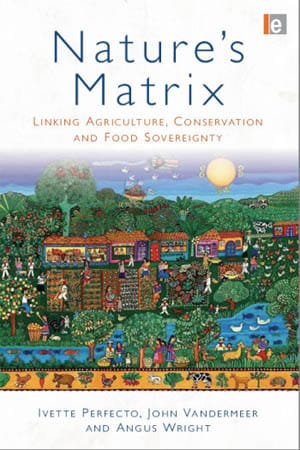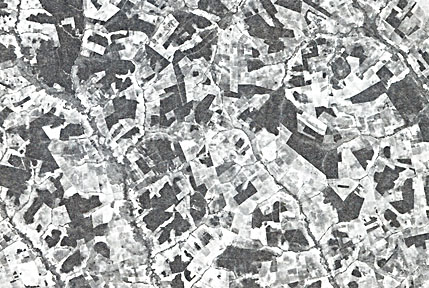Nature’s matrix: Linking agriculture, conservation and food sovereignty

Nature's Matrix: Linking Agriculture, Conservation and Food Sovereignty
By Ivette Perfecto, John Vandermeer, and Angus Wright
Earthscan, 2009
Review by Ian Angus
October 17, 2012 – Climate and Capitalism, posted at Links International Journal of Socialist Renewal with permission – In any discussion of biodiversity and species extinction, someone usually insists that overpopulation is the problem. More people equals more farms equals less wilderness equals more extinctions. Life is a zero-sum game: you can have people and farming OR wildlife and biodiversity, but not both.
For a powerful antidote to such views, I highly recommend Nature’s Matrix, an important book by ecologists Ivette Perfecto, John Vandermeer and Angus Wright. Drawing on their extensive practical experience with conservation and agriculture in Central America and the Amazon, combined with recent research in ecology and agronomy, they propose a radical “new paradigm” for conservation, a strategy based on powerful evidence that preserving biodiversity is inseparable from the growing struggle of peasant farmers for human rights, land, and sustainable agriculture.
The issue is not how many people there are, but what the people do: some forms of agriculture destroy life, others preserve and expand it. Only by strengthening the social forces that support biodiversity-friendly farming can we hope to slow or reverse what’s being called the "sixth extinction", a global species annihilation comparable to the death of the dinosaurs.
A doomed strategy
The orthodox approach to protecting biodiversity was expressed recently by David Attenborough, the well-known broadcaster and naturalist who is also a patron of the UK-based World Land Trust (WLT). In a letter to WLT supporters, Attenborough wrote:
On the reserves purchased through donations to the Trust, which are expertly managed by its overseas partners, permanent protection is in place. Buying land for conservation is the most direct and certain road to conservation and in doing so WLT is ensuring that at least some of our wilderness, and its biodiversity, survives.
Most conservation groups follow that approach: they try to protect biodiversity and limit species extinctions by creating wilderness reserves where human activity is limited or banned. Often they literally erect fences and pay armed guards to prevent intrusions, even by people whose ancestors lived on the land for millennia. What happens outside the reserves is only relevant if it threatens to impinge on the pristine environment where nature is protected from people.
Nature’s Matrix argues convincingly that such a focus on creating protected areas is a doomed strategy that actually harms biodiversity, increasing the likelihood of extinctions.
This is so for three reasons.
First, most tropical landscapes are not exclusively untouched or exclusively farmed, but a complex matrix with fragments of forest separated by a variety of farms, as this aerial photograph illustrates.

A fragmented landscape near Campo Grande, Brazil. Darker areas are remnants of natural vegetation embedded in a heterogeneous agricultural matrix
Despite the sincerity and hard work of conservationists, nature preserves will never represent more than a small fraction of biodiversity-rich areas.
Even as the world struggles to protect the few remaining large areas of tropical habitats from further exploitation, we must acknowledge that a large fraction has already been exploited and that perhaps most of the world’s biodiversity is located not in those few remaining protected natural areas, but in the far more extensive landscapes in which thousands of islands of natural habitat exist in a matrix of myriad agricultural activities (p. 31).
If a minimum of 50 per cent of the world’s surface is covered in managed ecosystems, and if managed ecosystems contain even a small fraction of the biodiversity contained in unmanaged ecosystems, ignoring them will be counterproductive, to say the least (p. 20).
Second, within natural habitats, even large ones, local extinctions are normal and inevitable. “Each subpopulation faces a certain likelihood of extinction. Accumulated evidence is overwhelming that extinctions, at this local subpopulation level, are ubiquitous” (p. 6). Local populations must be constantly reinforced by migrations from other areas. “As long as the migration rate balances the extinction rate, the population will survive over the long run.” (196) If migration is blocked or seriously inhibited, eventually all of the local populations will disappear and the species will be extinct.
Some kinds of agriculture block such migration, others facilitate it.
There is now little doubt that isolating fragments of natural vegetation in a landscape of low-quality matrix, like a pesticide-drenched banana plantation, is a recipe for disaster from the point of view of preserving biodiversity. It is effectively reducing the migratory potential that is needed if the metapopulations of concern are to be conserved in the long run (p. 5).
Third, the focus on creating preserves ignores the biodiversity that exists in farmed areas. “Many conservationists think of agriculture as the defining feature of biodiversity loss. The world gets divided into those areas untouched or minimally touched by Homo sapiens as contrasted to those areas ‘despoiled’ by human activity” (p. 18).
That view is simply wrong. It is not the existence of agriculture, but the type of agriculture, that determines whether biodiversity is preserved: “Some types of agro-ecosystems contain great amounts of biodiversity while others contain virtually none at all” (p. 204)
What kind of agriculture is most likely to produce a high-quality matrix? The intuitively obvious answer is confirmed by research.
Large-scale production of bananas, sugar cane, tea, technified coffee and cacao, soybeans, cotton, pastures, and others are notorious for their environmental unfriendliness. Small-scale farmers with their usually mixed farming techniques applying, either by conviction or necessity, organic-like and environment-friendly techniques, square far more obviously with the emerging concept of a high-quality matrix (pp. 209-10)
The authors aren’t naïve: they recognise that traditional farming isn’t always sustainable, and that some of what poses as organic farming is little different from industrial farming. Nor do they suggest that a single model applies everywhere: the most sustainable forms of agriculture depend on the farmers’ detailed knowledge of local conditions and their ability to adapt as conditions change. Nevertheless, experience and research show that a combination of traditional knowledge and the latest agro-ecological research can produce results that are biodiversity-friendly while producing as much food as high-input industrial farms.
A new paradigm
Unlike most books on environmental issues, Nature’s Matrix doesn’t limit itself to a description of the problem and pious wishes that “political will” for change will somehow emerge. Instead it asks what social forces can be mobilised to change the dominant agricultural model.
Clearly, we cannot expect change to come from the corporations that profit from ever-increasing use of pesticides and artificial fertilisers. Likewise, the giant food growers and processors whose empires depend on monocrop plantations are no friends of biodiversity – nor are the governments and international agencies that do their bidding.
But a countervailing force is growing.
In many developing countries the small farmers and the landless are organizing and demanding access to land and their right to a decent livelihood. These farmers’ organizations, increasingly organized under the banner of food sovereignty, sustainable agriculture and biodiversity conservation, are an integral component of the discourse (p. 129).
Using examples from the Brazil’s Landless Workers Movement (MST), Mexico’s Zapatistas, and others, Nature’s Matrix argues that the fight for biodiversity-friendly farming is inseparably linked to the growing international movement of small farmers against neoliberal agricultural policies and for what the umbrella organisation Via Campesina calls food sovereignty – “the conjoining of the rights of people to consume food to the rights of people to produce their own food” (p. 207).

Protest organised by La Via Campesina and Brazil’s Landless Workers Movement (MST).
If the phenomenal rise in rural grass roots social movements continues, it is here that the future of rural landscapes will be determined. Since it is the agriculture in the matrix that is key to the overall conservation agenda, as we have argued, the social movements that form the basis for the future organization of that agriculture become key players in the overall conservation agenda. The Via Campesina, with its philosophy of food sovereignty, agro-ecology and conservation of natural resources, offers an excellent example of where conservation energy should be placed at the present time (pp. 133-4).
Instead of working with local elites and governments, conservationists must ally with and support the social movements that can actually carry through agrarian revolutions. They must adopt a “new paradigm” ―
a reorientation of conservation activities, away from a focus on protected areas and towards the sustainability of the larger managed landscape; away from large landowners and towards small farmers; away from the romanticism of the pristine and towards the material quality of the agricultural matrix, nature’s matrix. At the centre of this new paradigm is the urgent need for social and environmental justice, without which the conservation of biodiversity ultimately becomes an empty shibboleth (p. 10).
The conservation strategy outlined in Nature’s Matrix “gives preference to more progressive political struggles for land rights over traditional lobbying for set-aside reserves of inviolate nature” (p. 211). It rejects blaming species extinctions on birth rates in poor countries, instead identifying the poorest people in those countries as allies. The authors conclude:
This new paradigm carries with it normative consequences. It suggests that conservation activities need to interact with the rural masses and their social movements more than with wealthy donors. Indeed, we suggest : that these new rural social movements hold the key to real biodiversity conservation. Joining the worldwide struggle of millions of small-scale farmers clamouring for food sovereignty is more likely to yield long-term biodiversity benefits than buying a patch of so-called ‘pristine’ forest (p. 213).
Some may call that conclusion utopian, but what’s truly unrealistic is the belief that small islands of biodiversity can somehow survive in rising oceans of industrial agriculture. Without an agro-ecological revolution, the "sixth extinction" cannot be stopped – and without the active involvement of mass peasant movements, the agrarian transformation cannot succeed.
Perfecto, Vandermeer and Wright have written a powerful social and scientific critique of current conservationist policies, and have outlined the basis for a radical alternative. Nature’s Matrix should be read and heeded by everyone who is concerned about the survival of life on earth.
[Ian Angus is editor of Climate and Capitalism, and co-author, with Simon Butler, of Too Many People? Population, Immigration and the Environmental Crisis.]